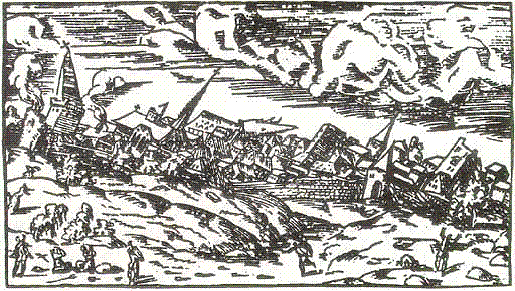Between 1341 and 1364, while the Hundred Years War was contesting the right of the English king to rule France (or, at least, parts of it), France was dealing with another struggle over Brittany. The Counts of Blois, a region south of Paris, claimed Brittany for their own, while the House of Montfort claimed it due to their link to the Dukes of Brittany.
When Duke John III "The Good" of Brittany (1286—1342) died, there were two rival claims. John was childless, and so the children of his siblings were next in line. John III had not liked the Montfort line which sprang from his father's second marriage, and favored his niece by his younger brother Guy. That nice, Joan of Penthièvre, had married Charles of Blois (a nephew of King Philip VI). But John repented shortly before his death, and made a will appointing John of Montfort his heir.
Most of the French nobility chose to accept the claim through Joan. John of Montfort moved quickly, however, making sure he possessed the chief cities of Nantes, Rennes, and Vannes, not to mention Limoges where the treasury of Brittany lay.
Although King Philip might have intended to stay apart from the conflict, he decided to side with Charles of Blois once he heard that Montfort had been in contact with England for support. A truce in the Hundred Years War meant that Edward could not take an active military role in supporting Montfort, but he might offer him financial and material aid.
A military intrusion into Brittany by French forces led to a siege at Nantes, and the capture of John of Montfort. His forces were not without a leader, however: his wife decided to take up arms, quite literally, the details of which I shall discuss tomorrow.
When Duke John III "The Good" of Brittany (1286—1342) died, there were two rival claims. John was childless, and so the children of his siblings were next in line. John III had not liked the Montfort line which sprang from his father's second marriage, and favored his niece by his younger brother Guy. That nice, Joan of Penthièvre, had married Charles of Blois (a nephew of King Philip VI). But John repented shortly before his death, and made a will appointing John of Montfort his heir.
Most of the French nobility chose to accept the claim through Joan. John of Montfort moved quickly, however, making sure he possessed the chief cities of Nantes, Rennes, and Vannes, not to mention Limoges where the treasury of Brittany lay.
Although King Philip might have intended to stay apart from the conflict, he decided to side with Charles of Blois once he heard that Montfort had been in contact with England for support. A truce in the Hundred Years War meant that Edward could not take an active military role in supporting Montfort, but he might offer him financial and material aid.
A military intrusion into Brittany by French forces led to a siege at Nantes, and the capture of John of Montfort. His forces were not without a leader, however: his wife decided to take up arms, quite literally, the details of which I shall discuss tomorrow.

































